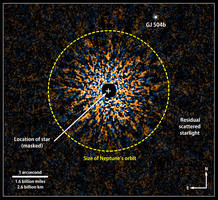the star GJ 504 using two wavelengths in the near infrared. Goddard Space Flight Center NASA / S. Wiessinger
 Video
Video exoplanets, ie planets outside our solar system, they are of many types. If in recent years it has discovered an exoplanet dark as coal or other small and rocky, a team of international astronomers has now photographed a giant planet around the bright star GJ 504, which, however, is the lowest-mass planet ever detected outside our solar system and magenta .
exoplanet, dubbed GJ 504b , has four times the mass of Jupiter . It orbits a star nearly nine times the distance Jupiter orbits the Sun, which poses new challenges theories about how giant planets form. To capture it, astronomers have used direct imaging, the infrared data Subaru telescope in Hawaii .
Planet GJ 504b has a temperature of 237 degrees Celsius, while the star around which orbits a little warmer than the Sun, is 57 light years away. According to astronomers study, published in The Astrophysical Journal , an estimated system has about 160 million years , based on methods that connect the color of the star and the rotation period to age, NASA has revealed in a statement.“If we could travel to the giant planet, we would see a world glowing with color reminiscent of a cherry blossom dark , a magenta color,” said a team member at NASA Center Goddard Space Flight, Michael McElwain, who stated: “Our near-infrared camera reveals that his color is much bluer than other planets photographed, which may indicate that its atmosphere has less clouds “.
New Challenges in theory formation of planets
According to the most accepted theory, known as core accretion model, Jupiter-like planets begin to disk debris rich gas surrounding a young star. A core produced by collisions between asteroids and comets provides a ‘seed’. When the core reaches sufficient mass, its gravity attracts disk gas to form the planet.
This model works well for planets that are in place in the orbiting Neptune. The magenta exoplanet GJ 504b, is located at a projected distance of 43.5 astronomical units from its star. The actual distance depends on the inclination with respect to our line of sight, which is not precisely known. “This planets is one of the most difficult to explain in the context of planet formation traditional “, explained team member and postdoctoral fellow at the University of Princeton, Markus Janson. “This discovery means we have to seriously consider planet formation theories alternatives, or perha ps reevaluate some of the basic assumptions of the core accretion theory”, has topped. The research is part of the exploration of exoplanets and disks with the Subaru telescope (SEEDS), a project to directly image extrasolar planets and protoplanetary disks around several hundred nearby stars. The project began in 2009 and is directed from the National Astronomical Observatory of Japan.
No comments:
Post a Comment